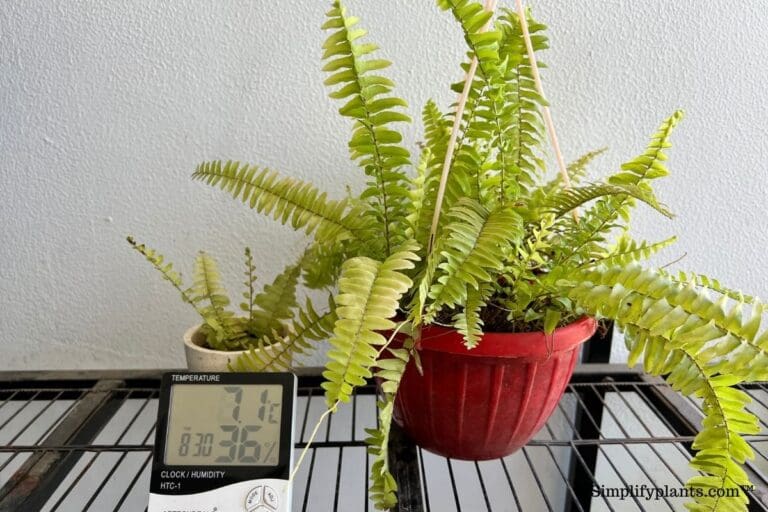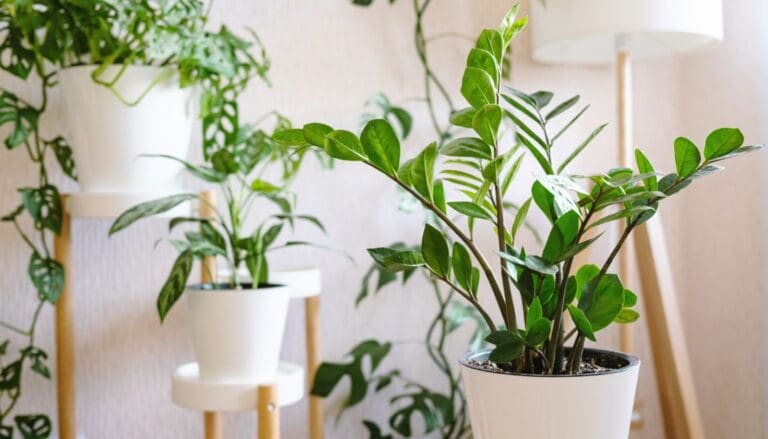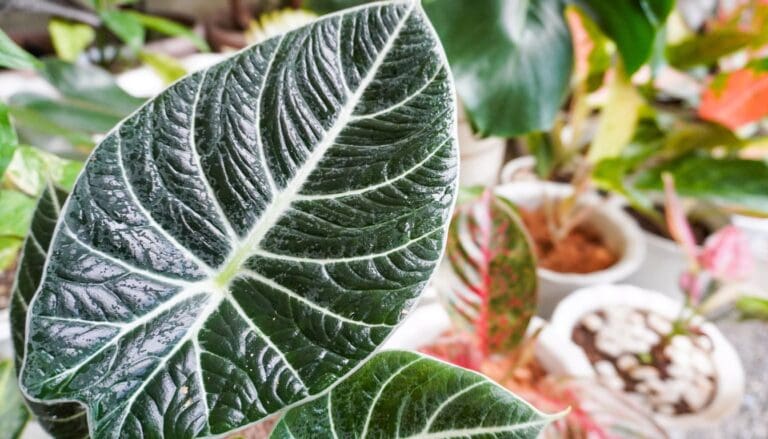How To Care For Peace Lily Indoor? (Ultimate Care Guide)
Peace lily or spathiphyllum is a typical tropical houseplant that has exotic green leaves and unique white flowers. Although peace lily is a low-maintenance plant, understanding its basic requirements can go a long way in keeping the plant healthy and growing.
If you have brought a new peace lily plant or plan to get one, you have arrived at the correct place as we will discuss everything you need to know about growing and caring for a peace lily indoors.
As a general rule, peace lilies require bright indirect light and an average room temperature between 68-85°F along with at least 50% humidity. You can use a well-balanced 20:20:20 liquid fertilizer to fertilize your peace lily and water it once a week or after the topsoil dries.
With care comes problems. You cannot expect your peace lily to remain healthy all its life as it might develop some problems that you would need to treat.
But if you gather the right set of knowledge, treating the problems and keeping your peace lily healthy will become easier.
Please note: Simplify Plants is reader-supported. Some links in the post are affiliate links and I get a commission from purchases made through links in the post.
Peace lily Overview

Peace lily or spathiphyllum originates from the tropical rainforests. The plant contains dark green pointed leaves and unique flowers. You will notice tiny flowers growing around a spike called a spadix, surrounded by a white leaf-like structure called a spathe.
The peace lily is often considered a symbol of peace, purity, healing, and hope. People not only grow it as a houseplant but also gift it to their loved ones. The air-purifying ability of the peace lily makes it more popular in households.
Peace lilies can grow between 4 to 6 feet tall and wide as houseplants. These plants love to remain slightly root-bound that even helps them to bloom.
Are peace lilies easy to grow?
Peace lilies are one of the easiest growing plants out there. No wonder it is a popular houseplant! The fact that it survives low light conditions makes it even more suitable as a houseplant.
That doesn’t mean you don’t need to think about or care about your peace lilies. However, the care required is not daunting. With little and the proper care, you can grow your peace lily with ease.
Also read: How Fast Does Peace Lily Grow? (+Factors To Consider)
Is Peace Lily indoor or outdoor?

The peace lily is a tropical plant which indicates that they prefer a warm environment with dappled sunlight. These plants cannot tolerate temperatures below 45°F.
Peace lilies are mostly grown as indoor plants. They need a controlled environment to thrive and cannot tolerate direct sunlight, making them an ideal indoor choice.
However, people living in the U.S. zones 11 and 12 can grow peace lilies outdoors. These regions include parts of Hawaii and Puerto Rico in the U.S.
Also read: Can Peace Lily Grow Outside? (+How To Care For Them Outdoors)
Peace Lily care
Peace lilies are low-maintenance houseplants that are easy to grow and an excellent choice for beginners.
Peace lilies are versatile and can adjust to low light conditions. All these plants might not ask for a lot of care; you still need to care for their basic requirements.
You must provide indirect light, correct temperature, and humidity levels, proper watering, appropriate potting mix, and occasional doses of fertilizers to take care of your peace lily.
Let’s find out the exact requirements of this species to avoid making any mistakes while taking care of it.
Peace lily light requirements
Peace lilies thrive in bright and indirect light. However, these plants can also tolerate low light conditions, making them popular in the house plant community.
A peace lily growing in low light will have slow growth compared to one growing in bright light.
In their natural habitat, peace lilies get dappled sunlight and stay protected from direct rays of the Sun. That is precisely what it requires, even as a houseplant.
You cannot expose your peace lily to direct sunlight, or else it will get scorched. Therefore, find a spot for your peace lily where it gets bright indirect sunlight if you want to see optimum growth.
Also read: What Kind Of Light Does A Peace Lily Need? (Peace Lily Light Requirements)
Peace lily water requirements
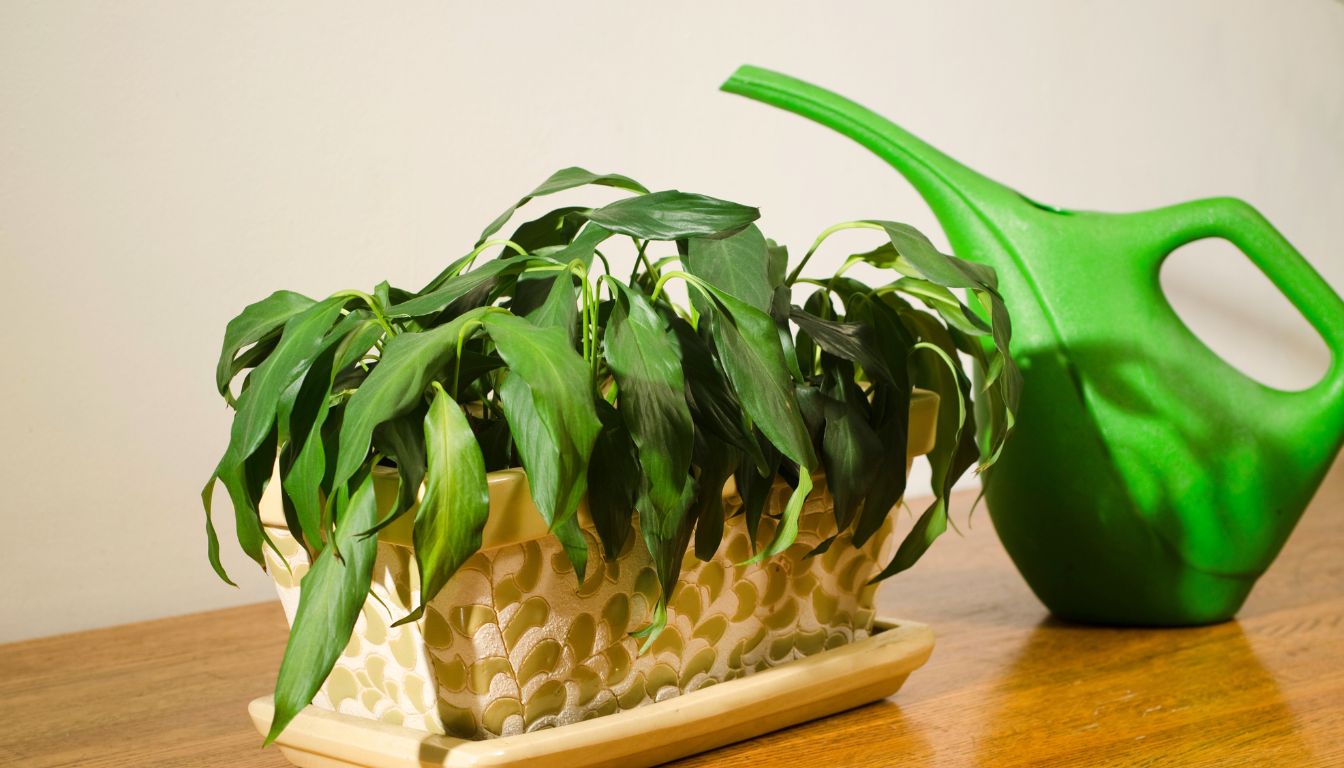
One common sign that your peace lily requires water is droopy leaves. However, you are supposed to keep a check on your plant and water it after the topsoil gets dry.
Always water thoroughly and let it drain out of the drainage holes. This will make sure that the roots are getting enough water.
Give a small amount of water to your peace lily and wait for a few seconds. Once the soil absorbs that water, add more.
Do not water your peace lily too frequently, as that will lead to overwatering and root rot.
If your peace lily is placed in a low light region, you must water it less. However, in a brighter spot, the plant will need more water.
The water requirement can also change as per the season. During winter, the peace lily will require less water due to the low temperatures. On the other hand, during the summer and spring seasons, it will need more water.
Also read: How Often Should A Peace Lily Be Watered? (Peace Lily Water Requirements)
Peace lily soil mix
Peace lilies need soil that can hold the required moisture and drain the excess water. A heavy soil mix will retain excess water, while a light soil mix will fail to hold the required moisture.
Therefore, you need to prepare a soil mix that balances retention and drainage for your peace lily.
Peace lilies require a slightly acidic soil mix that has a pH between 5.0 to 6.5.
You can prepare a soil mix for your peace lily by mixing sand, peat moss, and one part loam. This will provide nutrition to your peace lily and maintain a balance between retention and drainage of water.
Also read: What Kind Of Soil To Use For Peace Lily? (Peace Lily Soil Mix)
Peace lily fertilizer requirement

Peace lilies can survive even without fertilizers, but fertilizing is vital for its blooming and growth.
Peace lilies are light feeders and do not require a lot of fertilizer. You must fertilize it twice or thrice throughout the growing season with diluted liquid fertilizer.
A well-balanced 20:20:20 fertilizer diluted to half or a quarter strength is ideal for peace lilies. You must water your peace lily after fertilizing so that the fertilizers can get evenly spread into the soil and prevent root burn.
Avoid overfertilizing your peace lily as it will lead to brown spots on the leaves, and the flowers will appear a little greener.
Also read: What Kind Of Fertilizer Does A Peace Lily Need? (Peace Lily Fertilizer Ratio)
Temperature tolerance of peace lilies
Peace lilies are native to tropical regions where they are exposed to high-temperature levels.
Maintaining such temperatures indoors might not be possible, but your peace lilies will do well in average room temperatures. The ideal range falls between 65-80°F.
Peace lilies do not prefer temperature fluctuations as this can stress them out. You must not keep your peace lily near doors or windows that are opened and closed frequently as that can cause fluctuations.
Temperatures below 45 degrees are not suitable for peace lilies as they cannot tolerate low temperatures. You must protect your peace lily from cold drafts, frost, and low temperatures in winter.
Avoid keeping your peace lily near the fireplace, furnace, or other heat sources, as these will increase the temperatures and burn the plant’s leaves.
Also read: What Temperature Is Best For Peace Lily? (Ideal Range+How To Maintain)
Humidity for peace lilies

Peace lilies enjoy high humidity levels in their native lands, and humidity plays a vital role in the growth of these plants.
As a houseplant, peace lily requires humidity levels between 50-60%. If you can maintain this humidity range, your peace lily will thrive.
During winter, the humidity levels drop below the average range that can damage the plant, so you must be careful during this time and try to increase the humidity for your peace lily.
You can:
- Install a humidifier.
- Use a pebble tray.
- Group humidity-loving plants.
- Relocate to the bathroom, kitchen, or basement.
Also read: Do Peace Lilies Need Misting? (+Ideal Humidity)
Peace Lily pruning
Peace lilies require pruning when the flowers turn green and start drooping. These spent flowers are pruned by deadheading.
After a flower completes its lifecycle, it dies along with the stalk. You must prune the stalk close to the bottom to create space for new stalks.
Other than flowers and stalks, the damaged leaves and stems also require pruning. You need to prune to avoid overgrowth, the spread of infections, and boost growth.
Always use sharp and disinfected tools to prune your peace lily. Make precise cuts at an angle but don’t prune more than 25% at once.
Prune the peace lilies during spring and summer when the chances of stress are lowest.
Also read: How To Prune A Peace Lily? (When+Steps-By-Step Guide)
Peace lily repotting

Repotting is a necessary part of caring for your peace lily. Every houseplant requires repotting, and peace lily is no different.
Houseplants require repotting when they get rootbound. But peace lilies like to remain slightly rootbound. Therefore, you must report it once you notice signs like roots coming out of the drainage holes or the pot expanding.
A slightly rootbound peace lily will bloom more efficiently, so you should not report it too frequently.
However, you will need to report your peace lily to save it in conditions like root rot.
For repotting a peace lily, you need a part that is one size bigger than the previous one and a well-draining soil mix. You must prune all the damaged parts and add soil to the pot.
Place your peace lily inside the pot and add soil from the sides to avoid air pockets in the soil. Water your peace lily thoroughly to reduce the transplantation stress.
Repotting rejuvenates the plant with a fresh soil mix that can hold more nutrition as the old soil mix loses its nutrients over time.
As a thumb rule, all house plants require repotting once every 2-3 years.
Also read: Do Peace Lilies Like To Be Root Bound? (+When To Repot)
Peace Lily propagation
Peace lilies are different from most other houseplants in terms of propagation. You cannot propagate them with leaf or stem cuttings. You can propagate the peace lily through division.
For dividing a peace lily, you need a mature plant. First, you need to take the plant out of the old pot. Next, inspect the plant and find out spots where the foliage is attached to the roots.
If your peace lily is rootbound, you might need a knife to split the root ball. After dividing your peace lily, you can grow them in soil or water.
Provide bright indirect sunlight and sufficient water to help them grow well. Maintain the ideal temperature and humidity levels and fertilize on time.
You can propagate your peace lily if it has grown too big or you want to get new peace lily plants. Instead of buying new ones, you can divide your existing plant to get new ones.
You can even gift peace lilies to your loved ones after propagating them.
Peace Lily toxicity

Peace lilies contain calcium oxalates that are toxic for both pets and humans. Calcium oxalates are sharp crystals that can cause both skin and internal irritation.
If your pets and children touch the peace lily, it can lead to burning or swelling skin.
If consumed, peace lilies can irritate the lips, tongue, and mouth. It can also lead to vomiting and drooling.
You must take your pets to the clinic immediately if they have touched or consumed the peace lily plant and you notice unusual behavior in them.
You must also contact the doctor if your children have touched or ingested any part of the peace lily plant.
If pets or children are there in the house, you should find a safe spot for your Peace Lily, which is not accessible to either of them. This will keep your children and pet safe and the plant unharmed.
Also read: Are Peace Lily Toxic? (Cats, Dogs, Rabbit & More)
Peace Lily problems
Although peace Lily is an easy-to-grow plant, it can develop problems due to unfavorable conditions for lack of care.
You must not neglect your peace lily and keep an eye out for problems so that you can treat them on time.
Common problems that affect your peace lilies are root rot, discoloration of leaves, no bloom, etc.
Yellow leaves on peace lilies
Yellow leaves are a sign that your peace lily is not growing well.
The most common cause of yellow leaves is overwatering. If you have been watering your peace lily more than required out of too much care, your plant is overwatered, and it will develop problems.
Yellow leaves are the initial signs of overwatering, so you still have time to treat your plant.
Let your peace lily get dry before you water it again. Water only if the topsoil is dry.
Sometimes the leaves turn yellow when they have completed their lifecycle. These leaves will eventually fall off, so you must not worry about them.
Also read: Why Is My Peace Lily Turning Yellow? (Causes+How To Fix)
Brown tips on leaves
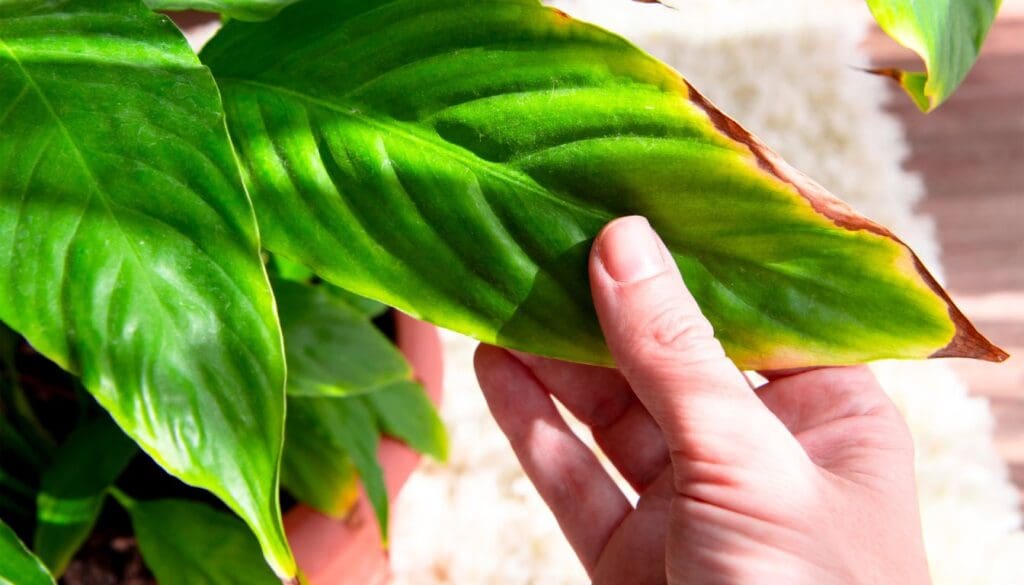
One common problem you will notice on your peace lilies is that the tips of the leaves turn brown. This happens due to direct light or insufficient humidity levels.
If your peace lily is exposed to direct sunlight, the tips of the leaves will get sunburnt and start turning brown. Eventually, the whole leaf will go brown.
If this is the issue, you must move your peace lily to a different spot where it is protected from direct sunlight and is exposed to indirect light only.
On the other hand, if humidity is the problem, try misting your peace lily regularly or install a humidifier to increase the humidity.
Also read: Why Do Tips Of Peace Lily Turn Brown? (Causes+How To Fix)
Black leaves on peace lilies

Black leaves signify that your peace lily has undergone some problems for an extended period without any care.
The most common reason behind black leaves is root rot. If your peace lily is overwatered, the roots will get affected due to sitting in water for too long.
The roots that remain in soggy soil for too long suffocate due to lack of oxygen and start rotting. When the root rot reaches an extreme condition, the leaves turn black.
It might be difficult for you to revive your peace lily from this condition, but if you notice any healthy roots after taking the plant out of the pot, you can report it after removing the damaged roots.
Temperature fluctuations can also make the leaves black. A sudden rise or fall in the temperature level can make the leaves black.
Exposing your peace lily to frost and heating systems can damage the leaves, shock the plant, and make the leaves black.
Fungal and bacterial infections caused due to improper watering and low light can result in black leaves.
If you water the leaves every time you water your peace, lily, it can lead to bacterial leaf spot disease where the leaves develop black spots.
If your peace Lily lives in low light, give it less water to save it from such problems.
Also read: Why Is My Peace Lily Turning Black? (Causes+Solution)
Curling leaves on Peace Lily

The leaves of peace lilies can curl due to poor quality water, overfertilization, or exposure to direct sunlight.
In their native lands, peace lilies remain under dappled sunlight, and they do not prefer direct sunlight.
Even as houseplants, peace lilies will not prefer direct sunlight, and dry curled leaves might result from direct sunlight.
You can fix this by moving your peace lily to a different spot that only receives indirect sunlight.
Another reason is using the wrong type of water on your peace lily.
If you are using regular tap water, your plant might be getting harmful minerals like chlorine, fluorine, etc. You should instead switch to filtered water or rainwater to get rid of the curled leaves.
If you fertilize your peace lily too often or give it a lot of fertilizer, it can develop curly leaves.
You must stop fertilizing and let the plant recover. After it recovers, fertilize once a month or once every 6 weeks. Use a diluted dose to avoid overfertilization.
Also read: Why Are My Peace Lily Leaves Curling? (Causes+How To Fix)
My peace lily is not blooming

The peace lily is loved for its beautiful white blooms. But sometimes, the Peace Lily plant might not bloom. The reason behind this can be low light, lack of fertilization, or temperature shifts.
Peace lilies survive low light conditions, but low light does not ensure proper growth and bloom.
A peace lily placed in low light will fail to bloom due to insufficient energy. You can relocate the plant to a brighter spot and wait for it to bloom.
If you think you have not fertilized your peace lily enough, consider fertilizing it more often. You can fertilize it once a month and check the response of the plant.
Use a well-balanced 20:20:20 fertilizer and dilute it to half-strength and apply it to your peace lily.
Keep your peace lily protected from temperature shifts as these plants are sensitive to temperature fluctuations.
If you maintain the ideal temperature of 70-75°F during summer and spring and 60-65°F in winter, your peace lily might start blooming again.
Do not expect the peace lily to bloom if the plant is too young. Give it time to mature.
Droopy leaves on peace lily
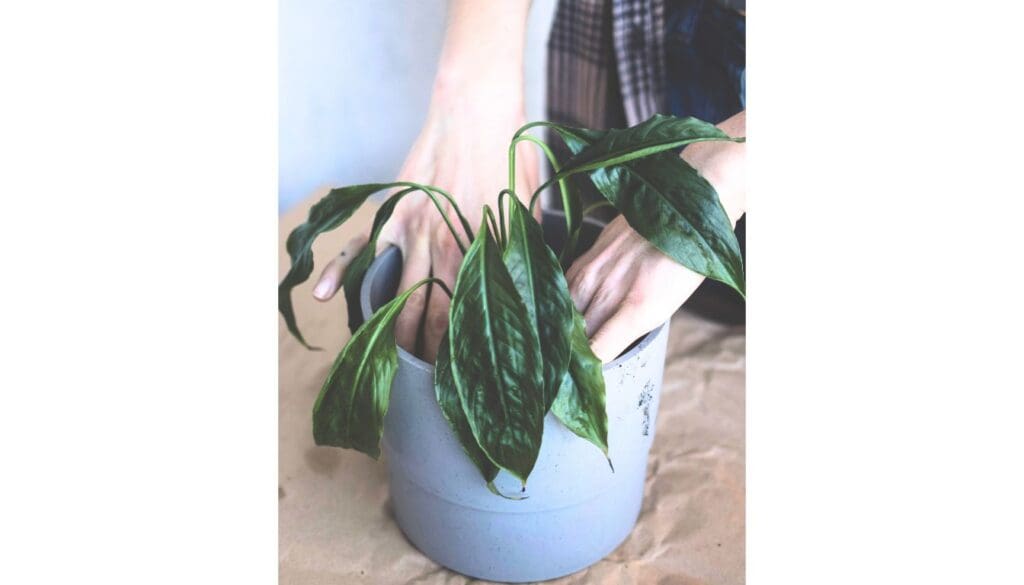
You might notice droopy leaves on your peace lily, which occur due to a lack of water. A thirsty peace lily shows you that it needs water through the droopy leaves.
You can give your peace lily some water and let the soil soak it in. After that, water the plant thoroughly. You will notice that the leaves look healthy a few minutes after you water the plant.
On the other hand, overwatering also causes droopy leaves.
If the peace lily gets too much water, the roots stop functioning, so the plant doesn’t get enough water or nutrients. This makes the plant droopy.
You should water your peace lily only when the topsoil is dry. Avoid watering the leaves while watering the plant.
Pest infestations can also cause droopy leaves. Pests like mealybugs feed on the plant sap, taking out all the nutrients from the plant.
The plant loses all energy, and as a result, the leaves droop.
You can spray a neem oil solution on your peace lily regularly to get rid of the mealybugs.
Also read: Why Is My Peace Lily Drooping? (Causes+How To Fix)
Root rot in peace lilies
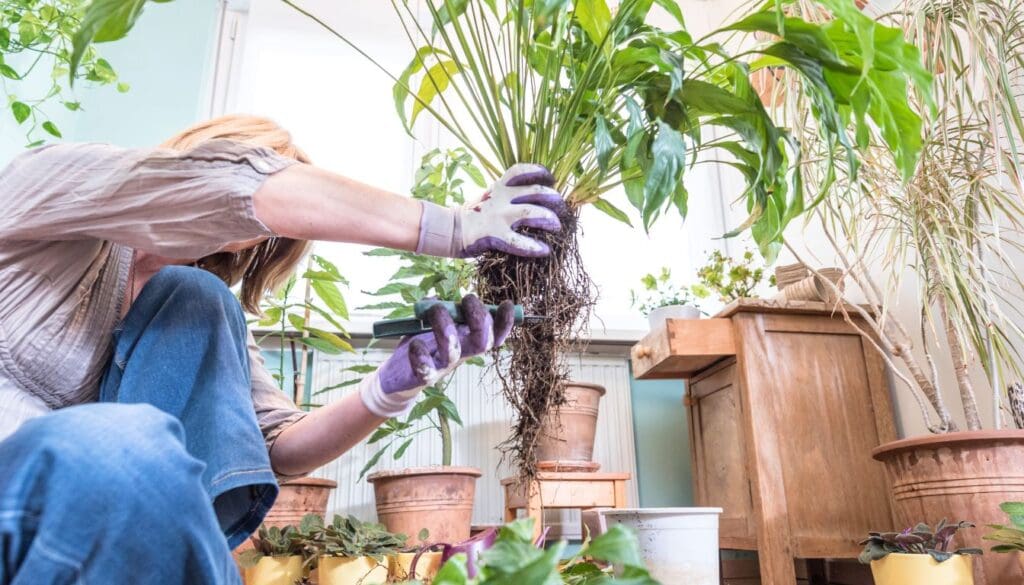
Overwatering causes different problems that ultimately lead to root rot which every plant owner dreads.
Overwatering makes the soil soggy as the soil doesn’t get a chance to try up and keeps receiving more and more water. When the roots stay in this condition for too long, they suffocate and start to rot.
These roots become unhealthy and turn brown and mushy. They fail to function and carry water and nutrients to the plant. The plant becomes weak and vulnerable to pest infestation, bacterial and fungal infections.
Repotting becomes the only option to revive your peace lily from this situation. You must prune the damaged roots and repot the peace lily in a new pot and fresh potting soil.
If the condition is even worse, you can divide the plant or discard it.
Also read: How To Treat Root Rot In Peace Lily? (Signs, Identification & More)
Peace lily pests
Peace lilies are not prone to pest infestations, but in rare situations, you might find that pests have attacked your peace lily.
Pests like mealybugs, aphids, scales, and thrips can attack the peace lily if they live in unfavorable conditions. These pests suck the sap of the peace lily, making the plant weak.
Getting rid of the pests as soon as possible is the best way of saving your peace lily. Give the plant a good shower with a strong stream to remove as many pests as possible.
Dip a cotton ball in alcohol and spread it on the affected areas or the parts where you notice the pests.
You can also spray a neem oil solution on your peace lily daily for at least two weeks.
Remember to keep your peace lily away from other plants so that the pests don’t spread.
Also read: Where Should Peace Lily Be Placed? (Ideal Spot+Placement Tips)
Peace lily care tips

Peace lilies don’t require much time and attention, but taking care of their basic needs can go a long way.
Here is an overview of all the factors that you should consider after bringing a peace lily home.
Light: Peace lilies require bright indirect light to thrive. One of the best things about a peace lily is that it can survive in low light conditions. You might notice slow growth or no flowers if your peace lily is living in low light. You can change its spot to provide more indirect light to see faster growth and beautiful blooms.
Water: Peace lilies require water only when the topsoil is dry. You can water your peace lily once a week but only after checking the soil. Using poor quality water can lead to brown leaves, so use rainwater or filtered water to water your peace lily. Reduce the watering during winter.
Soil: A balance of retention and drainage is what works best for peace lilies. Use a potting mix that contains elements that will retain enough water and drain the excess. Make sure that the soil contains nutrients that will help your peace lily grow.
Temperature: Peace lilies thrive in warm environments. The ideal temperature for fiddle leaf figs is between 70–75°F during summer and spring and 60-65°F during winter. Temperature fluctuations or temperatures below 45°F can be damaging for the plant.
Humidity: Peace lilies prefer more humidity as it comes from the tropical region. The ideal humidity for these plants will be between 50-60%. You must be careful about the humidity during winter when the humidity levels drop.
Fertilizer: Many owners skip fertilizing their peace lilies, but we have noticed more growth and bloom on the fertilized peace lilies. Dilute a well-balanced 20:20:20 fertilizer to half strength and give it to your peace lily to see optimum growth.
Pruning: You must prune the spent flowers and stalks of your peace lily to make space for new blooms. Pruning is necessary to eliminate the damaged or diseased parts, dead and discolored leaves, and control the excess growth.
Repotting: As a general rule, you must report your peace lily at least once every 2-3 years. However, unlike most plants, peace lily likes to remain slightly root-bound, which helps it bloom. So you must repot it only when you notice signs of it being rootbound, such as roots showing up on the soil or coming out of the drainage holes. But in cases like root rot, you will need to prune the rotten roots and repot the peace lily as soon as possible.
Propagation: Propagation can help if your peace lily is dying or you want to get a new peace lily. You cannot propagate a peace lily with stem or leaf cuttings. You need to divide the plant to propagate it. You can hold the plant at the base and take it out of the pot. If the root ball is tangled, you can slice through it with a knife to divide the plant. Now, you can grow the plants in soil or water.
Also read:
FAQ
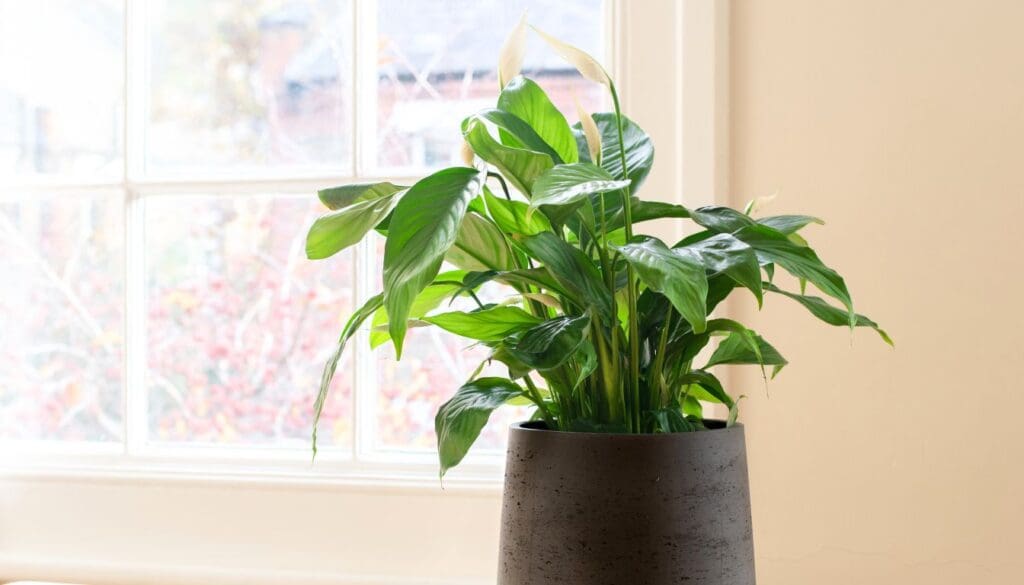
What are peace lilies good for?
Besides adding a beautiful look to your living space with dark green leaves and white flowers, peace lilies are great air purifiers. It makes peace lilies even more popular. Peace lilies break down toxic gases like carbon monoxide and benzene and minimize the harmful effects of these. Peace lily also releases oxygen at night.
Where should I place peace lily in my house?
Peace lilies thrive in a bright environment. So, if you have a south or west-facing window in your house, you can place the peace lily in front of that window. Use curtains to filter the direct sunlight. If no window gets enough light in your house, or you want to keep the peace lily in your office, consider keeping it under fluorescent lights.
Also read: Where Should Peace Lily Be Placed? (Ideal Spot+Placement Tips)
How long do peace lilies live?
The lifespan of the peace lily can depend on the plant, and it cannot be predicted. However, in general, the peace lilies can live between 3-5 years.
How many times does peace lily bloom?
While some peace lilies bloom only once a year, most of the peace lilies that you see nowadays grow flowers twice a year, once in the spring and then in the fall. These flowers can live up to two months before they finally die.
Ref: ScienceDirect, NCBI, University of Vermont, Nationalgeographic, NC state university, University of Florida, The University of Arkansas, Queensland Government.
Recommended Garden Supplies
| Product Image | Our Recommended Gardening Supplies | Check Offers! |
|---|---|---|
Top Top
Top
Top
Top
Top
Top
Top
Top | rePotme Houseplant and Tropical Classic Potting Soil Mix | Check Offer On Amazon |
 Top
Top
Top
Top
Top
Top
Top
Top | Espoma Organic Indoor Plant Food | Check Offer On Amazon |
 Top
Top
Top
Top
Top
Top
Top
Top | GooingTop LED Grow Light 6000K Full Spectrum Clip Plant Growing Lamp | Check Offer On Amazon |
 Top
Top
Top
Top
Top
Top
Top
Top | Soil Moisture Meter | Check Offer On Amazon |
 Top
Top
Top
Top
Top
Top
Top
Top | Govee Hygrometer Thermometer, Bluetooth Enabled! | Check Offer On Amazon |
 Top
Top | LEVOIT Humidifiers for Large Room(Best For Plants) | Check Offer On Amazon |
 Top
Top
Top
Top
Top
Top
Top
Top | Upgraded DIY Automatic Drip Irrigation Kit, 15 Potted Houseplants Support | Check Offer On Amazon |
 Top
Top
Top
Top
Top
Top
Top
Top | Stainless Steel Heavy Duty Gardening Tool Set | Check Offer On Amazon |
 Top
Top
Top
Top
Top
Top
Top
Top | Bonide Insecticidal Soap | Check Offer On Amazon |
 Top
Top
Top
Top
Top
Top
Top
Top | Bonide 32 oz Spray Neem Oil for Organic Gardening | Check Offer On Amazon |
 Top
Top
Top
Top
Top
Top
Top
Top | Garden Safe Fungicide | Check Offer On Amazon |

